Bulletin – February 2008 Developments in the Farm Sector[1]
- Download 122KB
Introduction
The 2000s have been an especially challenging period for the farm sector. In the decade to date the agricultural regions of Australia have experienced historically dry conditions, while average temperatures have been the highest on record.[2] Flows into the Murray-Darling Basin have been historically low, and, despite continued improvements in farm management, farm output remains below the level seen in 1999. More recently, however, the development of a La Niña weather system, and flooding rains in New South Wales and Queensland, have seen the outlook for the year ahead improve significantly – although a strong rebound in farm output will most likely require further significant follow-up rains over the winter months.
While the farm sector in Australia has had a particularly difficult period, poor harvests have also occurred in several other large food-producing countries over recent years. Together with strong underlying demand, this has seen global food prices increase significantly. With demand likely to continue to be underpinned by rapid economic growth in developing economies and the trend toward biofuel production, real food prices may remain higher than seen over recent decades for some time.
Recent Climatic Developments
After two years of drought, the outlook for climatic conditions in the farm sector has improved over recent months. A La Niña weather system (which is normally associated with higher-than-average rainfall) has become firmly established in the Pacific region. Consistent with this, recent rainfall across many of the major cropping regions has been well above average; severe flooding has been experienced in New South Wales and Queensland. Given that the majority of farm product is related to the winter crop, which has already been harvested for 2007/08, the Australian Bureau of Agricultural and Resource Economics (ABARE) is forecasting only a modest recovery in farm output in 2007/08. However, the outlook is becoming more positive for 2008/09. Nevertheless, given the extent of earlier dryness in most agricultural regions, it is likely that a sustained period of well-above-average rainfall will be needed to return the irrigated sector to more normal conditions over the medium term.
The Current Decade in an Historical Context
The climatic conditions faced by the farm sector so far this decade have been historically severe. The Bureau of Meteorology records two main indicators of the severity of drought: geographic spread and degree of dryness. Geographic spread is gauged by the proportion of land with rainfall in the lowest 10 per cent of historical experience, while degree of dryness is measured by average rainfall in a given period compared with historical experience.[3] On each of these criteria, both the 2002 and 2006 droughts were among the most severe and widespread drought episodes on record (Graph 1). In addition, the gap between these droughts was unusually short, with the only comparable episode being the short period between the droughts of 1940 and 1944. In trend terms the share of agricultural land recording a rainfall deficiency is now around historical highs while the annual mean rainfall in the agricultural regions is around historical lows.
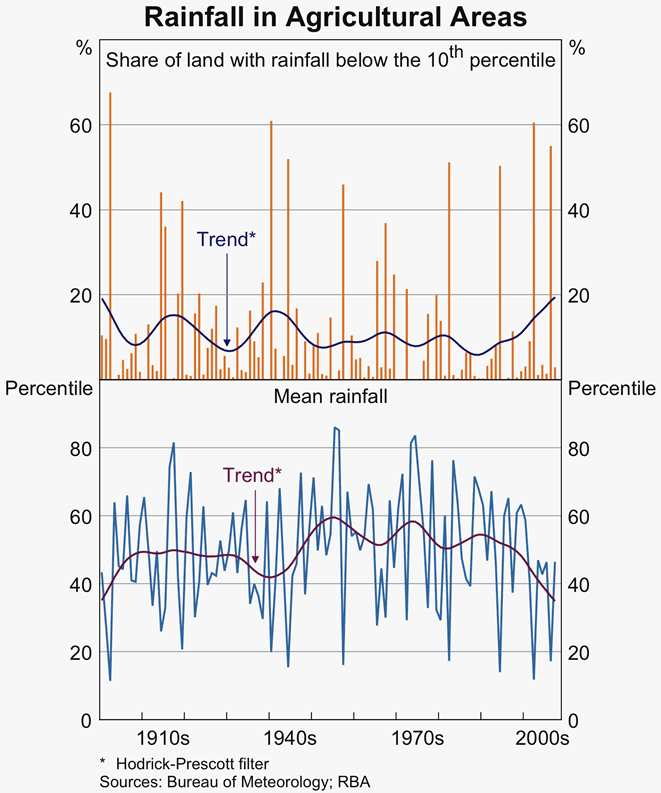
The current decade has also seen the highest average temperatures in the agricultural areas since at least the 1950s (Graph 2). Not surprisingly given the above factors, the current decade has seen the lowest average annual flows into the Murray-Darling Basin of any decade since data were first collected (Graph 3).
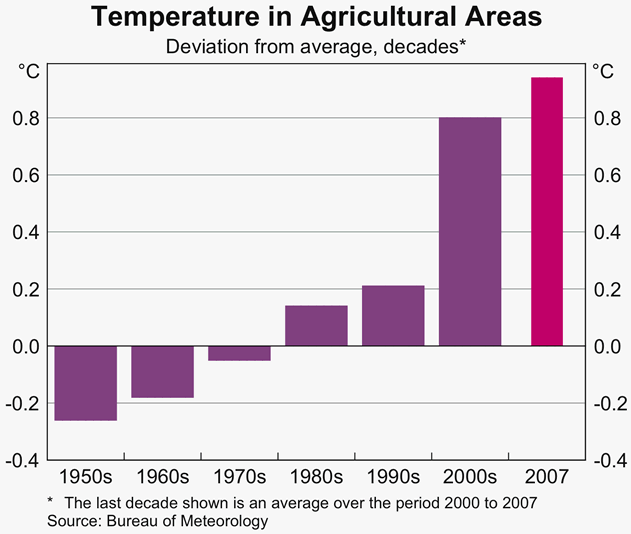
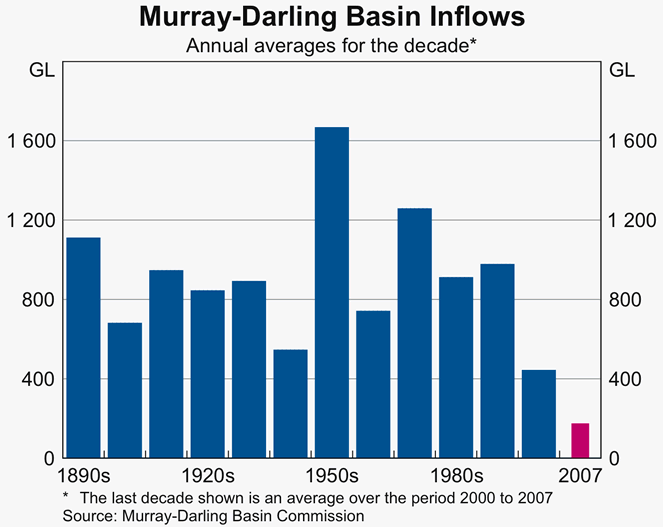
Faced with these climatic conditions, real farm output is experiencing one of the worst decades on record, with farm output in the current fiscal year forecast by ABARE to remain below that recorded at the beginning of the decade (Graph 4). This has seen the post-WWII decline in the farm sector's share of the overall economy continue.
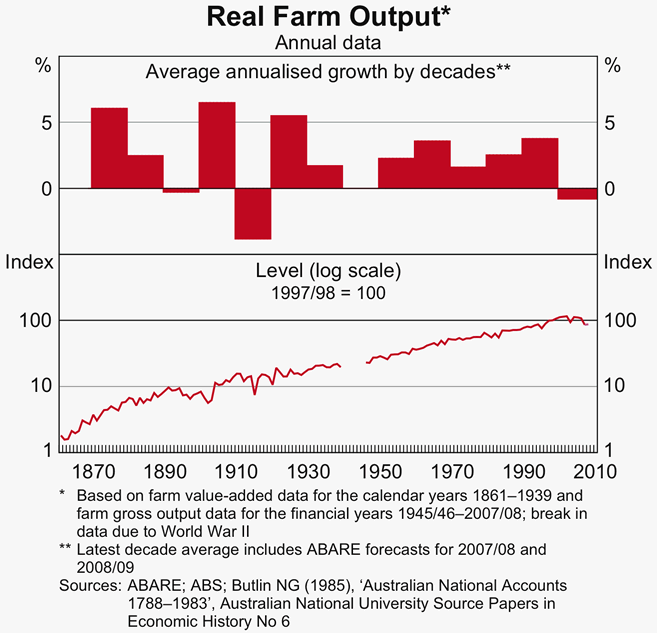
The Drought in a Global Context
While the drought in Australia has been severe, supply problems have also occurred in several other major agricultural exporting countries. For instance, weather-related supply disruptions have occurred in large grain-exporting regions such as the United States and the European Union, while in China drought and the rezoning of rural land have affected rice production.[4] These supply disruptions have occurred against the backdrop of relatively strong global growth in demand for food. Strong income growth and improving living standards in emerging economies, such as China and India, have led to significant growth in demand for protein in recent years.[5] In addition, higher energy prices have prompted substitution towards biofuels, which has increased demand for some commodities, such as corn. While food and feedstock usage of grains remain larger than that for biofuels, demand for biofuel has been growing rapidly. This is partly due to government policy changes, with more than 40 countries implementing policies to encourage the use of biofuel in recent years.
These factors have seen global stocks of wheat, other coarse grains and rice fall to relatively low levels, resulting in significant increases in global food prices (Graph 5). The combination of poor harvests in several major food-producing countries, high energy prices and continued strong demand for farm produce suggests that it is likely that relatively high global food prices will be sustained in the near term. This is consistent with the high level of futures prices for many agricultural goods.
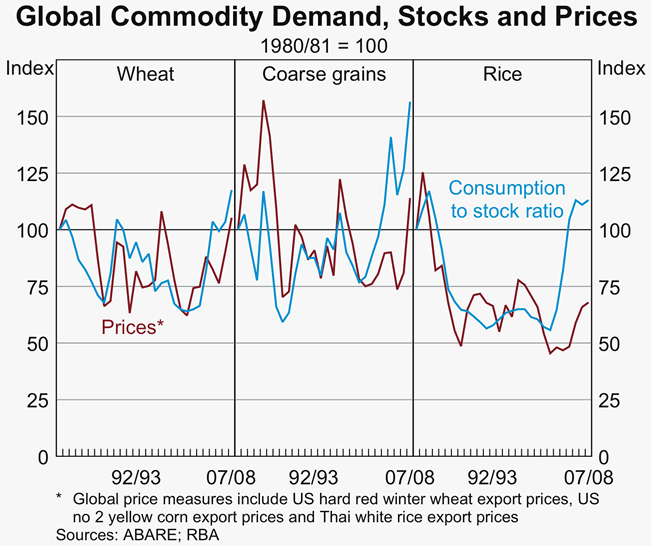
Implications of the Drought for Domestic Inflation
Over the past couple of years increases in food prices have outpaced overall inflation in Australia (Graph 6). This is in contrast to the experience in recent periods of drought, where average food prices increased at around the same rate as the overall CPI. There are several reasons why droughts have historically had relatively small effects on the CPI. First, the contribution of commodity prices to final retail food prices is generally small. Second, the contribution of drought-affected food prices to the overall CPI is relatively minor.[6] Third, while cereal prices generally rise during a drought, meat prices tend to fall as livestock slaughter rates rise in response to the dry conditions. Finally, many food items can be imported in the event of shortfalls in production, and there is also some scope for food manufacturers to engage in ingredient substitution limiting the effect on domestic prices.
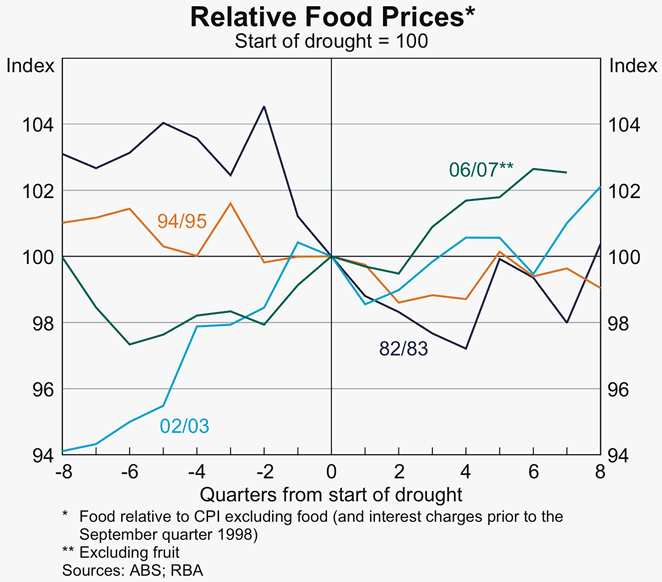
The sustained rise in the relative price of food in the current drought can largely be explained by the fact that a broader range of food items has been affected by this drought than in previous episodes. For example, the duration of the drought, and the extent of the decline in stored water levels, have contributed to sharp falls in dairy and vegetable production, which has caused the prices of these items to rise more markedly than in previous droughts. Consistent with this, the outlook for Australian food prices over the coming year is likely to depend primarily on domestic conditions, such as the level of rainfall. However, increases in global food prices may continue to exert some upward pressure on domestic prices, as the prices of both food exports and imports increase.
Footnotes
This article was prepared by Deniz Ortac, Gianni La Cava and Ric Deverell of Economic Analysis Department. [1]
Analysis by ABARE and the Bureau of Meteorology suggests that average temperatures are likely to rise over coming decades, and that the mean (and variability) of rainfall will decrease (increase). [2]
While it is usual to consider these indicators across the whole country, when assessing the economic implications of the drought it is more instructive to focus on rainfall deficiencies in major agricultural districts and water storage areas. The data shown draw on rainfall data compiled by the Bureau of Meteorology for the prime agricultural districts in eastern, southern and western parts of the country. For further details, see ‘The Drought’, Statement on Monetary Policy, November 2006, pp 33–37. [3]
China accounts for around 30 per cent of total global rice production. [4]
Protein is generally more resource-intensive than other diets, as meat is more expensive to produce than grain on a per calorie basis. [5]
While expenditure on food accounts for around 15 per cent of the CPI basket in Australia, around half of this is spent on food items that are not directly affected by drought, such as restaurant meals, takeaway foods, non-alcoholic drinks and snack foods. [6]